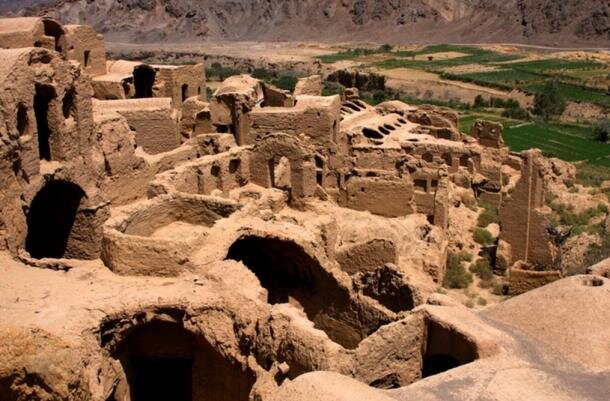Kharanaq: a deserted, crumbling but dreamy destination

TEHRAN - Serenely situated in a remote valley about 70km north of Yazd in central Iran, is the deserted and crumbling mud-brick village of Kharanaq.
Kharanaq approximately dates 4,000 years, while its dilapidated adobe buildings that draw sightseers from around the world date back around 1,000 years.
The abandoned town is a photographer’s dream with a labyrinth of streets, tunnels, passageways, and rooms, as well as more impressive buildings such as a tiny mosque, a shaking minaret, and an old caravanserai that welcomed merchants and pilgrims centuries ago, according to Ancient Origins.
Meaning ‘place of birth of the sun’, Kharanaq is divided into two parts – the Old Town, which is almost completely deserted, and the New Town, where tens of families continue to live.
The Old Town was constructed with sun-baked mud bricks, forming one of the largest collections of adobe buildings in Iran. It was once a prosperous farming village, but when water supplies dried up the inhabitants left, leaving the town to turn to ruins, Ancient Origins writes.
While most of the Old Town of Kharanaq consists of crumbling homes and collapsing roofs, there remain some historically important and well-preserved monuments.
In recent years, a New Town was constructed within 2km of the ancient town with government-supplied water and electricity. Apart from a few elderly people who refused to leave their old houses and continue to live among the ruins, the rest of the Old Town’s inhabitants moved to the New Town.
There are several magnificent monuments inside the village. A Qajar-era (1789–1925) mosque has been fully restored and stands with a 15-meter-high minaret, known as the Shaking Minaret of Kharanaq. The 17th-century minaret has three floors and a spiral staircase winding its way up inside. The minaret is frequently seen shaking and vibrating. The cause of this phenomenon remains unknown.
Another blue-domed mosque stands out against the earthen colors of the surrounding town and landscape.
Moreover, a well-preserved caravanserai – a place where merchant caravans are halted – from the time of the Qajar dynasty sits on the edge of Kharanaq. The caravanserai is fortified with stables for pack animals, storage areas, and rooms for travelers passing through.
Other highlights include an old castle linked to the historical periods of Islam, ancient aqueducts built to irrigate the surrounding fields, and an ancient but still functional bridge.
The last remnants of this historic and awe-inspiring city are now under threat due to the existence of iron, uranium, barite, zinc, and granite deposits in the surrounding area. The Saghand mine located 60km west of the village extracts some of these valuable minerals, and it is only a matter of time before profits are placed before the preservation of this ancient town.
The oasis city of Yazd is wedged between the northern Dasht-e Kavir and the southern Dasht-e Lut on a flat plain ringed by mountains. Its historical structure enjoys a very harmonious public-religious architecture that dates from different eras.
Described as the “noble city of Yazd” by Marco Polo, Yazd is widely believed to date from the 5th century CE. It stands on a mostly barren sand-ridden plain about 4,000 feet (1,200 meters) above sea level. Since Sassanian times Yazd has been famous for beautiful silk textiles that were rivaled in later periods only by those of Kashan and Isfahan. The city is still a major center of silk weaving.
With its winding lanes, a forest of badgirs (windcatchers), mud-brick houses, atmospheric alleyways, and centuries of history, Yazd is a delightful place to stay, referring to a ‘don't miss’ destination by almost all travel associates in the region.
Yazd is a living testimony to the intelligent use of limited available resources in the desert for survival. Water is brought to the city by the qanat system. Each district of the city is built on a qanat and has a communal center. The use of earth in buildings includes walls and roofs by the construction of vaults and domes. Houses are built with courtyards below ground level, serving underground areas. Wind-catchers, courtyards, and thick earthen walls create a pleasant microclimate.
AFM
